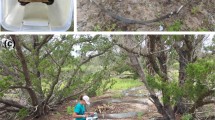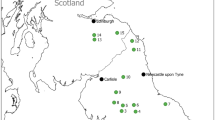Abstract
Grassland-breeding shorebirds show widespread declines due to a reduction in breeding productivity following agricultural intensification. However, there is also concern that increasing predation causes further declines or precludes population recovery. Predation may itself be enhanced by agriculture through changes in habitat or food availability, but little is known about the mortality of nidifugous shorebird chicks. We studied mortality by radio-tagging 662 chicks of Black-tailed Godwit Limosa limosa and Northern Lapwing Vanellus vanellus in 15 farmland sites in the Netherlands. Tagging and handling had no effect on the condition and survival of godwit chicks, but body condition was reduced by 6–11% in lapwing chicks wearing a tag for longer than 3 days. Fledging success was 0–24% in both species. Mortality was highest in young chicks but remained considerable until after fledging. Losses were traced mostly to predators (70–85%; 15 species, predominantly birds), but at least 5–10% were due to mowing, and 10–20% were due to other causes, including entrapment in ditches and starvation. Chicks staying in fields that were cut before the next radio check were found much more often as mowing victims and somewhat more often as prey remains than chicks in fields not cut, indicating that predation includes a limited amount of scavenging. The predation hazard for godwit chicks was higher in recently cut or grazed fields than in the tall, uncut grasslands they preferred, while that for lapwing chicks was lowest in grazed fields. In godwit chicks, poor body condition increased mortality risk, not only from starvation but also from other causes. Predation on godwit chicks was thus enhanced by intensive farming through a decline in the availability of cover, augmented by a reduced body condition, possibly due to food availability problems. Changes in farming practice may therefore help reduce predation pressure, though the observed interactions explained only part of the high predation rate in godwits and none in lapwings. Predator abundance has increased in Dutch wet grassland regions, and chick predation has become a factor that should be considered in planning the type and location of conservation measures.


Similar content being viewed by others
References
Baines D (1990) The roles of predation, food and agricultural practice in determining the breeding success of the Lapwing (Vanellus vanellus) on upland grasslands. J Anim Ecol 59:915–929. doi:10.2307/5022
Beintema AJ (1995) Fledging success of wader chicks, estimated from ringing data. Ringing Migr 16:129–139
Beintema AJ, Visser GH (1989) Growth-parameters in chicks of Charadriiform birds. Ardea 77:169–180
Beintema AJ, Thissen JB, Tensen D, Visser GH (1991) Feeding ecology of Charadriiform chicks in agricultural grassland. Ardea 79:31–43
Beintema AJ, Dunn E, Stroud D (1997) Birds and wet grasslands. In: Pain DJ, Pienkowski MD (eds) Farming and birds in Europe: the common agricultural policy and its implications for bird conservation. Academic, San Diego, pp 269–296
Besbeas P, Freeman SN, Morgan BJT, Catchpole EA (2002) Integrating mark-recapture-recovery and census data to estimate animal abundance and demographic parameters. Biometrics 58:540–547. doi:10.1111/j.0006-341X.2002.00540.x
Bolton M, Tyler G, Smith K, Bamford R (2007) The impact of predator control on Lapwing Vanellus vanellus breeding success on wet grassland nature reserves. J Appl Ecol 44:534–544. doi:10.1111/j.1365-2664.2007.01288.x
Combreau O, Qiao J, Lawrence M, Gao X, Yao J, Yang W et al (2002) Breeding success in a Houbara Bustard Chlamydotis [undulata] macqueenii population on the eastern fringe of the Jungar Basin, People’s Republic of China. Ibis 144:E45–E56. doi:10.1046/j.1474-919X.2002.00054.x
Cox DR (1972) Regression models and life tables. J Roy Stat Soc B 34:187–220
Cramp S (ed) (1983) The birds of the western Palearctic, vol 3. Oxford University Press, Oxford
Evans KL (2004) The potential for interactions between predation and habitat change to cause population declines of farmland birds. Ibis 146:1–13. doi:10.1111/j.1474-919X.2004.00231.x
Galbraith H (1988) Effects of agriculture on the breeding ecology of Lapwings Vanellus vanellus. J Appl Ecol 25:487–503. doi:10.2307/2403839
Grant MC (2002) Effects of radiotagging on the weight gain and survival of Curlew Numenius arquata chicks. Bird Stud 49:172–176
Grant MC, Orsman C, Easton J, Lodge C, Smith M, Thompson G et al (1999) Breeding success and causes of breeding failure of curlew Numenius arquata in Northern Ireland. J Appl Ecol 36:59–74. doi:10.1046/j.1365-2664.1999.00379.x
Green RE (1988) Effects of environmental factors on the timing and success of breeding of Common Snipe Gallinago gallinago (Aves, Scolopacidae). J Appl Ecol 25:79–93. doi:10.2307/2403611
Green RE (2002) Diagnosing causes of population declines and selecting remedial actions. In: Norris K, Pain DJ (eds) Conserving bird biodiversity. Cambridge University Press, Cambridge, pp 139–156
Green RE, Hirons GJM, Kirby JS (1990) The effectiveness of nest defense by Black-tailed Godwits Limosa limosa. Ardea 78:405–413
Kaplan EL, Meier P (1958) Nonparametric estimation from incomplete observations. J Am Stat Assoc 53:457–481. doi:10.2307/2281868
Kenward RE, Robertson PA, Coates AS, Marcström V, Karlbom M (1993) Techniques for radiotagging Pheasant chicks. Bird Stud 40:51–54
Korschgen CE, Kenow KP, Green WL, Johnson DH, Samuel MD, Sileo L (1996) Survival of radiomarked canvasback ducklings in northwestern Minnesota. J Wildl Manage 60:120–132. doi:10.2307/3802046
Krapu GL, Pietz PJ, Brandt DA, Cox RR (2006) Mallard brood movements, wetland use, and duckling survival during and following a prairie drought. J Wildl Manage 70:1436–1444. doi:10.2193/0022-541X(2006)70[1436:MBMWUA]2.0.CO;2
Langgemach T, Bellebaum J (2005) Predation and the conservation of ground-breeding birds in Germany. Vogelwelt 126:259–298
Larson MA, Clark ME, Winterstein SR (2001) Survival of ruffed grouse chicks in northern Michigan. J Wildl Manage 65:880–886. doi:10.2307/3803037
Miller BJ, Knopf FL (1993) Growth and survival of mountain plovers. J Field Ornithol 64:500–506
Ottvall R (2005) Breeding success and adult survival of Redshank Tringa totanus on coastal meadows in SE Sweden. Ardea 93:225–236
Payne R (2005) The guide to Genstat release 8. Part 2: Statistics. VSN International, London
Peach WJ, Thompson PS, Coulson JC (1994) Annual and long-term variation in the survival rates of British Lapwings Vanellus vanellus. J Anim Ecol 63:60–70. doi:10.2307/5583
Pearce-Higgins JW, Yalden DW (2003) Golden Plover Pluvialis apricaria breeding success on a moor managed for shooting Red Grouse Lagopus lagopus. Bird Stud 50:170–177
Pietz PJ, Krapu GL, Brandt DA, Cox RR (2003) Factors affecting gadwall brood and duckling survival in Prairie Pothole Landscapes. J Wildl Manage 67:564–575. doi:10.2307/3802714
Ratcliffe N, Schmitt S, Whiffin M (2005) Sink or swim? Viability of a Black-tailed Godwit population in relation to flooding. J Appl Ecol 42:834–843. doi:10.1111/j.1365-2664.2005.01076.x
Riley TZ, Clark WR, Ewing DE, Vohs PA (1998) Survival of ring-necked pheasant chicks during brood rearing. J Wildl Manage 62:36–44. doi:10.2307/3802262
Schekkerman H, Beintema AJ (2007) Abundance of invertebrates and foraging success of Black-tailed Godwit (Limosa limosa) chicks in relation to agricultural grassland management. Ardea 95:39–54
Schekkerman H, Müskens G (2000) Produceren Grutto’s Limosa limosa in agrarisch grasland voldoende jongen voor een duurzame populatie? Limosa 73:121–134
Schekkerman H, Visser GH (2001) Prefledging energy requirements in shorebirds: energetic implications of self-feeding precocial development. Auk 118:944–957. doi:10.1642/0004-8038(2001)118[0944:PERISE]2.0.CO;2
Schekkerman H, Teunissen W, Oosterveld E (2005) Broedsucces van grutto’s bij agrarisch mozaïekbeheer in ‘Nederland Gruttoland’. Alterra-report 1291, Alterra, Wageningen
Schekkerman H, Teunissen W, Oosterveld E (2008) The effect of ‘mosaic management’ on the demography of Black-tailed Godwit Limosa limosa on farmland. J Appl Ecol 45:1067–1075. doi:10.111/j.1365-2664.2008.05106.x
SOVON (2002) Atlas van de Nederlandse broedvogels 1998–2000. Nationaal Natuurhistorisch Museum Naturalis, Leiden
Swennen C (1989) Gull predation upon eider Somateria mollissima ducklings—destruction or elimination of the unfit? Ardea 77:21–45
Teunissen W (2007) Afname van weidevogels versnelt sinds eeuwwisseling. SOVON-nieuws 20:15–17
Teunissen WA, Soldaat LL (2006) Recente aantalsontwikkeling van weidevogels in Nederland. Levende Natuur 107:70–74
Teunissen WA, Schekkerman H, Willems F (2005) Predatie bij weidevogels. SOVON-onderzoeksrapport 2005/11. SOVON, Beek-Ubbergen
Teunissen W, Schekkerman H, Willems F (2006) Predation on meadow birds in The Netherlands: results of a four-year study. Osnabrucker Naturwiss Mitt 32:137–143
Teunissen W, Schekkerman H, Willems F, Majoor F (2008) Identifying predators of eggs and chicks and their relative importance for the reproductive output of Lapwing Vanellus vanellus and Black-tailed Godwit Limosa limosa in The Netherlands. Ibis (in press). doi:10.1111/j.1474-919x.2008.00861.x
Thorup O (2006) Breeding waders in Europe 2000. Internat Wader Stud 14. International Wader Study Group, Exeter
Vickery JA, Tallowin JR, Feber RE, Asteraki EJ, Atkinson PW, Fuller RJ et al (2001) The management of lowland neutral grasslands in Britain: effects of agricultural practices on birds and their food resources. J Appl Ecol 38:647–664. doi:10.1046/j.1365-2664.2001.00626.x
Whittingham MJ, Percival SM, Brown AF (1999) Evaluation of radiotelemetry methods in measuring habitat choice by young Golden Plover Pluvialis apricaria chicks. Bird Stud 46:363–368
Wilson AM, Ausden M, Milsom TP (2004) Changes in breeding wader populations on lowland wet grasslands in England and Wales: causes and potential solutions. Ibis 146[Suppl 2]:32–40. doi:10.1111/j.1474-919X.2004.00371.x
Acknowledgments
This work was supported by Natuurmonumenten, Staatsbosbeheer, the Union of Dutch Landscapes, Birdlife Netherlands, Landschapsbeheer Nederland, the provinces of Drenthe, Flevoland, Fryslan, Gelderland, Noord-Holland, Noord-Brabant, Overijssel and Zeeland, the Ministry of Agriculture, Nature Management and Food Quality and the Postcode Loterij. Fieldwork was conducted by L. Beskers, K. Bouwman, I. Geelen, P. Heemskerk, Y. van der Heide, B. Henstra, H. de Jong, M. de Jong, A. van Kleunen, M. Kuiper, F. Majoor, G. Müskens, W. Nell, R. Oosterhuis, H.-J. Ottens, K.-P. Plas, T. Meijer, E. Vromans, F. Weijdema and F. Willems. Many farmers and volunteers provided assistance by establishing contacts, providing access to land, finding and monitoring nests and many other ways. Patrick Jansen and Hans-Peter Koelewijn advised on the survival analysis. Rudi Drent and Piet Heemskerk commented on drafts of this paper. Radio-tagging of chicks complied with Dutch law on animal experiments.
Author information
Authors and Affiliations
Corresponding author
Additional information
Communicated by F. Bairlein.
Rights and permissions
About this article
Cite this article
Schekkerman, H., Teunissen, W. & Oosterveld, E. Mortality of Black-tailed Godwit Limosa limosa and Northern Lapwing Vanellus vanellus chicks in wet grasslands: influence of predation and agriculture. J Ornithol 150, 133–145 (2009). https://doi.org/10.1007/s10336-008-0328-4
Received:
Revised:
Accepted:
Published:
Issue Date:
DOI: https://doi.org/10.1007/s10336-008-0328-4




